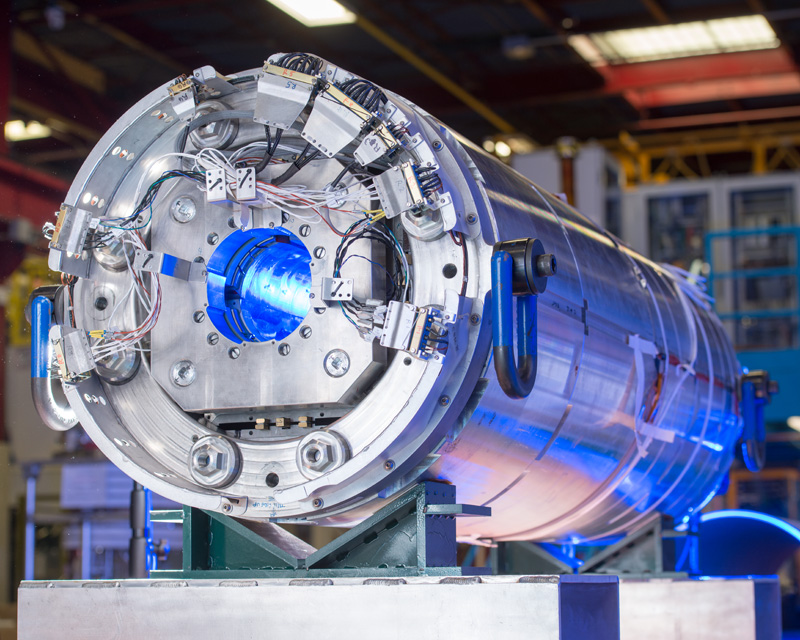
Berkeley Lab is part of a collaboration among several U.S. national laboratories that has been working on superconducting magnets (one is pictured here) integral to a planned high-luminosity upgrade for CERN’s Large Hadron Collider. (Credit: Reidar Hahn/Fermi National Accelerator Laboratory)
Note: This article was adapted from a Fermi National Accelerator Laboratory announcement. View the original announcement here.
A groundbreaking ceremony today celebrates the start of civil engineering work for a major upgrade to the Large Hadron Collider at CERN in Geneva, Switzerland. When complete, the High-Luminosity LHC (HL-LHC) will produce five to seven times more proton-proton collisions than the currently operating LHC, powering new discoveries about our universe.
The U.S. research was conducted via the LHC Accelerator Research Program, or LARP, which involves four U.S. Department of Energy laboratories: Lawrence Berkeley National Laboratory (Berkeley Lab), Fermi National Accelerator Laboratory, Brookhaven National Laboratory, and SLAC National Accelerator Laboratory. Now the research turns into reality, as construction of the new components begins.
Among the components contributed by the U.S. for the HL-LHC construction are powerful superconducting magnets and superconducting deflecting cavities (called crab cavities) of a novel compact design never before used in an accelerator.
In the LHC, superconducting quadrupole magnets focus the beams into collision at four points around the 27-kilometer ring. In the HL-LHC, these focusing magnets must be more powerful to focus the stream of particles much tighter than in the LHC. A collaboration including Berkeley Lab, Fermilab, and Brookhaven Lab developed the basic technology for these new magnets through LARP. The final design was completed in collaboration with CERN for application in the HL-LHC upgrade.
VIDEO: An overview of CERN’s High-Luminosity Large Hadron Collider, a major upgrade to the world’s large particle collider. (Credit: CERN)
The new magnets are made of a niobium-tin alloy that allows the magnets to reach the desired high magnetic field of 12 tesla. This powerful field is created by running a very high electric current through coils of superconducting wire, which conduct electricity without resistance when cooled to almost absolute zero. The U.S. in total is delivering half of the quadrupole magnets for the upgrade, while CERN is completing the other half.
Berkeley Lab’s contributions, through its Berkeley Center for Magnet Technology (BCMT), include 102 superconducting wire cables to be used in the magnets, the insulation of the cables, and the assembly of 25 4-meter-long quadrupole magnets (MQXFA) that will focus the LHC’s particle beams. Berkeley Lab’s Physics Division is also involved in testing next-generation components for detector upgrades needed for the HL-LHC.
The labs’ combined efforts will be coordinated through a DOE Office of Science-funded U.S. HL-LHC Accelerator Upgrade Project (AUP).
“Our contributions to the upgrade project exemplify one of Berkeley Lab’s strengths: co-operation with other laboratories,” said Associate Laboratory Director James Symons. “The U.S. contribution to the accelerator upgrade has been made possible by the very successful LARP collaboration, which developed the design concept over the past decade.”
Wim Leemans, director of the Accelerator Technology and Applied Physics (ATAP) Division, added, “These magnets show how contributions to projects grow from scientific and engineering leadership.” ATAP – a partner with the Engineering Division in the BCMT, and headquarters for the high-energy-physics-oriented U.S. Magnet Development Program – performs extensive R&D at all phases, from superconducting materials to design and construction of magnets.
These magnets will be the first use of the high-field superconducting material known as “niobium-three-tin” (Nb3Sn) in an operating accelerator, noted Soren Prestemon, head of Berkeley Lab’s BCMT. He added, “This is a unique collaboration where expertise in all areas of magnet technology is shared among the participating laboratories, resulting in a very tightly interwoven team.”
Fermilab scientist Giorgio Apollinari, who leads the U.S. HL-LHC AUP, said, “This is a truly major milestone for the whole U.S. accelerator community.”
He added, “More than 10 years of research work funded by DOE under LARP have gone into developing these cutting-edge magnets and crab cavities and in demonstrating their technical feasibility for the intended application at HL-LHC. We now look forward with much anticipation to shipping the first components to CERN and seeing them operate as part of the world’s foremost particle collider.”
Once it’s up and running, the HL-LHC will produce up to 15 million Higgs bosons per year, compared to the 4 million produced during the LHC’s 2015-2017 run. The higher luminosity will mean big changes for the LHC experiments as well, such as the Berkeley Lab-involved ALICE experiment, and the ATLAS and CMS detectors are undergoing major upgrades of their own.
More:
###
Lawrence Berkeley National Laboratory addresses the world’s most urgent scientific challenges by advancing sustainable energy, protecting human health, creating new materials, and revealing the origin and fate of the universe. Founded in 1931, Berkeley Lab’s scientific expertise has been recognized with 13 Nobel prizes. The University of California manages Berkeley Lab for the U.S. Department of Energy’s Office of Science. For more, visit www.lbl.gov.
DOE’s Office of Science is the single largest supporter of basic research in the physical sciences in the United States, and is working to address some of the most pressing challenges of our time. For more information, please visit science.energy.gov.